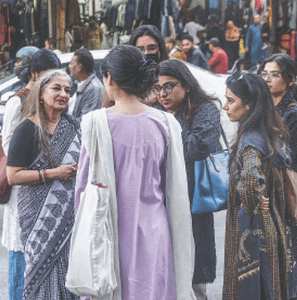“YOUR manuscript is good and original, but what is original is not good and what is good is not original,” goes the quote attributed to Samuel Johnson, the wit and the lexicographer.
Johnson, or whosoever really said it, was euphemistically referring to plagiarised portions of a manuscript. Plagiarism is an attempt to get attention and appreciation, though in the end it proves to be counterproductive as ‘original’ and ‘good’ portions of a plagiarised work, too, in case there happen to be any, are blemished by accusations.
Plagiarism is unacceptable, both morally and legally. But what to say of a literary work that is simply a fraud? There are quite a few examples wherein someone tried to present forged literary works as genuine, either for monetary gains or literary recognition. It is said that the great library at Alexandria -- established in 305 BC by a companion of Alexander the Great, named Ptolemy -- held manuscripts of works by great scholars such as Aristotle and Euripides, but they were all fake. So it seems that literary forgery is quite old, perhaps as old as is plagiarism. Nicholas Parsons in his book The Book of Literary Lists has given details of some of the forged and fake works, including diaries of Hitler, exclusive rights of which were sold for $400,000.
A hajv, or derogatory poem, severely criticising Mahmood Ghaznavi for not keeping his words, is attributed to Firdousi, the great Persian poet and creator of Shahnama. But most researchers agree that it was not written by Firdousi and was most probably composed after his death.
When it comes to fraudulent literary manuscripts, our part of the world, too, is not ‘barren’ and we have some ‘brilliant’ yet unsuccessful endeavours. Ghalib, because of awe and grandeur attached to his name, has suffered most from fakers. For instance, Abdul Bari Aasi, otherwise quite a good scholar, “discovered” some ghazals by Ghalib and got them published in Nigaar with the claim that those were Ghalib’s unpublished ghazals that he had found in a handwritten, old notebook. Eventually, it was revealed that Aasi himself had composed those ghazals. But he had so perfectly copied Ghalib’s diction and style that even Imtiaz Ali Khan Arshi, one of the great authorities on Ghalib, had them included in the first edition of his thoroughly researched version of Ghalib’s Urdu divan, by far the most authentic of them all. Those ghazals were expunged from the second edition.
Another forgery to take advantage of Ghalib’s name was committed by Ismail Rasa Hamadani Gyavi. He claimed to have found Ghalib’s 27 unpublished letters written to his grandfather. The style was strikingly similar to that of Ghlaib’s. But it was found that the purported letters were in fact nothing but a collection of sentences borrowed from Ghalib’s published letters and put together in logical sequence.
An Urdu divan of Ghalib was discovered in India and was smuggled to Pakistan. Nuqoosh, Lahore, published a facsimile but many scholars believe the divan, called Nuskha-e-Amroha, was a fake one. Another divan of Ghalib surfaced in Lahore some 20 years ago and soon became a bone of contention. Dr Moin-ur-Rahman claimed to have purchased a handwritten manuscript of Ghalib’s Urdu divan from a roadside dealer of old books. Moin Sahib edited and annotated it and proudly presented it. But some scholars challenged the genuineness of the manuscript, known as Nuskha-e-Khwaja. Dr Tehseen Firaqi meticulously researched the entire work and with solid proofs established the fact that it was the same manuscript called Nuskha-e-Sherani, which had been stolen from Punjab University Library. Earlier, Dr Syed Abdullah had introduced it in details. Dr Firaqi also found numerous errors in its annotations and editing.
Interestingly, Lataef-e-Ghaibi, a book written to defend Ghalib on the issue of Qaat’e-e- Burhaan had Mian Dad Khan Sayyah’s name as author on its title, but Ghalib himself had ghost-written it and attributed it to Sayyah, his friend.
Though many Sufi saints have penned great works, some others never wrote any books. Some books are believed to have been written by some Sufis but history does not support such claims. Khaleeq Anjum in his book Matni Tanqeed writes that Prof Muhammad Habib has proved that many works attributed to the Sufis of Chishtiya order are in fact not written by them. Some unscrupulous traders dealing in books got several books written by some mediocre writers, published them and attributed them to Sufis for monetary gains. Also, some of the works attributed to some great Sufi saints are in fact their ‘malfoozaat’, or their spoken words noted down by their disciples.
Naval Kishor had published several editions of a divan, supposedly written by Hazrat Khwaja Moinuddin Chishtie Ajmeri. But Mahmood Sherani proved that it was penned by Maulana Moinuddin and not by Hazrat Khwaja Moinuddin.
Published in Dawn, October 4th, 2021


































